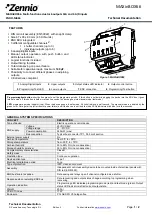
Element1
Element2
Frame 1
Element3
Element4
Frame 2
Element5
Element6
Frame 3
Element7
Element8
Frame 4
HTUREQ
HTUREQ
HTUREQ
HTUREQ
Element Count =2
Frame count =4
Control
Memory Protection
FIFO
HTU
N2HET
Data
Data
Address
Normal
Request
Quiet
Request
8
8
Control Packet
RAM
with Parity
S
C
R
2
Module Operation
1134
SPNU563A – March 2018
Copyright © 2018, Texas Instruments Incorporated
High-End Timer Transfer Unit (HTU) Module
Figure 24-2. HTU Block Diagram
Transfers between N2HET RAM and the main memory are triggered by 8 different normal N2HET
requests. Quiet requests are used for specific cases and are discussed in
. Control
packets, which store the source and destination addresses, the transfer count and other information (see
), are associated with the requests. A FIFO decouples the read- and write-path and allows to
do data-packing in the case of different read- and write-data sizes. The application can specify a section of
memory into or from which the data is transferred. This serves as memory protection in the case that
information in the control packet RAM was unintentionally altered and avoids that the HTU can overwrite
important application data.
Control packets are implemented as double control packets (DCP) which allow to specify two buffers for
the data transfer. This enables the CPU to work with one buffer, while new data is transferred to/from the
other buffer.
The control packet defines:
•
the start address of the source/destination buffers
•
the N2HET instruction address location
•
how many elements need to be transferred per request
•
the buffer size as the number of elements times the number of frames
•
the buffer handling
A transfer is triggered when a certain condition (for example, capture, compare condition) is detected by a
N2HET instruction. The N2HET instruction specifies which request line to the HTU will be triggered at the
event. The DCPs have a fixed assignment to the request lines and the corresponding assignment can be
found in the device datasheet. Once a request is triggered, it starts a frame transfer. A frame can contain
one or more elements. Elements are defined as 32-bit or 64-bit words of data.
Figure 24-3. Example of a HTU Transfer














































